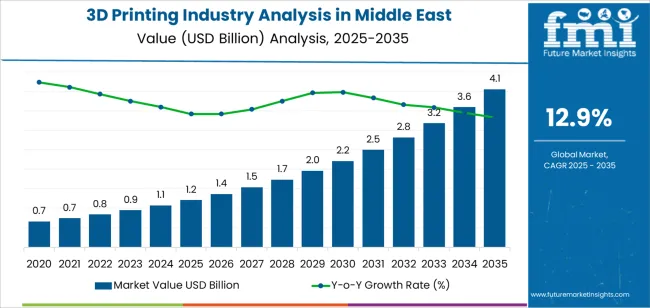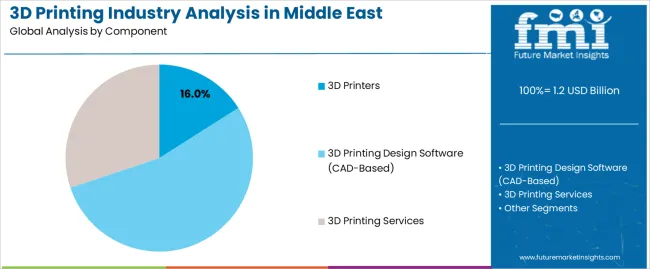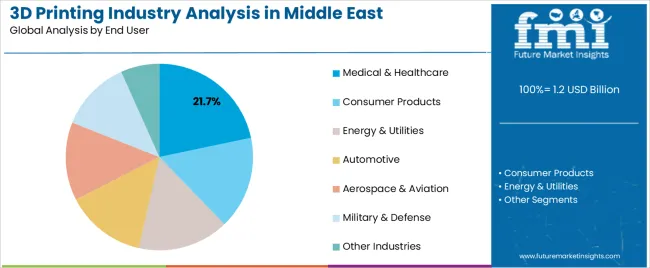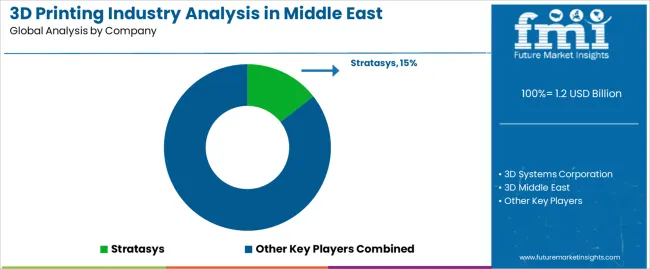The 3D printing industry in the Middle East is gaining traction, propelled by ongoing industrial diversification efforts, increasing investments in additive manufacturing, and government-led innovation initiatives. Regional policy frameworks such as the UAE’s Industry 4.0 strategy and Saudi Arabia’s Vision 2030 have prioritized advanced manufacturing technologies, including 3D printing, to reduce import dependence and localize production.
Industry updates and tech-focused government forums have spotlighted the expanding adoption of 3D printing in key sectors such as healthcare, construction, aerospace, and automotive. Additionally, regional universities and research centers have been investing in additive manufacturing capabilities, supporting the development of local expertise and innovation pipelines.
The availability of cost-effective 3D printing hardware and growing partnerships between Middle Eastern governments and global tech companies are further accelerating adoption. Over the next decade, the market is expected to experience steady expansion, supported by increased public-private collaboration, infrastructure investments in manufacturing hubs, and the integration of AI and advanced materials into 3D printing workflows.

| Metric | Value |
|---|---|
| 3D Printing Industry Analysis in Middle East Estimated Value in (2025 E) | USD 1.2 billion |
| 3D Printing Industry Analysis in Middle East Forecast Value in (2035 F) | USD 4.1 billion |
| Forecast CAGR (2025 to 2035) | 12.9% |
The market is segmented by Component and End User and region. By Component, the market is divided into 3D Printers, 3D Printing Design Software (CAD‑Based), and 3D Printing Services. In terms of End User, the market is classified into Medical & Healthcare, Consumer Products, Energy & Utilities, Automotive, Aerospace & Aviation, Military & Defense, and Other Industries. Regionally, the market is classified into North America, Latin America, Western Europe, Eastern Europe, Balkan & Baltic Countries, Russia & Belarus, Central Asia, East Asia, South Asia & Pacific, and the Middle East & Africa.

The 3D Printers segment is projected to contribute 16.0% of the Middle East 3D printing industry revenue in 2025, establishing itself as a critical component segment. Growth in this segment has been driven by increasing investments in localized manufacturing capacity and the demand for rapid prototyping tools across sectors such as defense, construction, and education.
Regional governments have funded several innovation hubs equipped with industrial-grade 3D printers to encourage on-demand manufacturing and reduce dependency on imported components. Hardware manufacturers have introduced scalable printer models tailored to regional industrial needs, including large-format and metal-based printers suited for infrastructure and aerospace applications.
Additionally, the affordability of desktop printers has encouraged adoption by small and medium-sized enterprises and academic institutions, expanding the segment’s user base. With continued emphasis on localized production and digital manufacturing resilience, the 3D Printers segment is expected to retain its importance as a foundational component of the region’s additive manufacturing landscape.

The Medical & Healthcare segment is projected to hold 21.7% of the 3D printing industry revenue in the Middle East in 2025, positioning it as the leading end-user segment. This growth has been supported by the increasing integration of 3D printing into personalized medicine, surgical planning, and prosthetics development across the region.
Hospitals and research institutions have adopted 3D printing for anatomical modeling, enabling enhanced surgical accuracy and patient outcomes. Government healthcare programs have promoted digital innovation in clinical care, creating demand for cost-effective and customized medical devices.
Additionally, local production of prosthetic limbs and dental implants using 3D printing has improved accessibility and reduced treatment timelines, particularly in underserved areas. Industry announcements have highlighted collaborative initiatives between medical universities and 3D printing firms to drive research in bioprinting and regenerative medicine. As the region continues to modernize healthcare infrastructure and invest in precision medicine, the Medical & Healthcare segment is expected to sustain its leading role in driving 3D printing adoption.
The table below shows the expected CAGR for the 3D printing industry in the Middle East across several semi-annual periods from 2025 to 2035.
| Particular | Value CAGR |
|---|---|
| H1 | 18.8% (2025 to 2035) |
| H2 | 18.6% (2025 to 2035) |
| H1 | 19.2% (2025 to 2035) |
| H2 | 18.7% (2025 to 2035) |
During the first half (H1) of the decade spanning from 2025 to 2035, the industry is anticipated to increase with a CAGR of 18.8%, followed by a slightly lower growth rate of 18.6% in the second half (H2) of the same period.
Moving forward to the subsequent period, from H1 2025 to H2 2035, the CAGR is expected to see a slight increase to 19.2% in the first half while remaining relatively moderate at a slightly lower 18.7% in the second half.
3D Printing Alters Construction in the Middle East, from Prototypes to Skyscrapers
At first, 3D printing was mainly for making prototypes and trying out new ideas. But now, it's gotten much better and can be used for big construction projects too. In places like the Middle East, where they have a knack for big, fancy buildings, 3D printing is becoming popular.
It helps builders work faster and make really detailed structures. This new way of building is changing how architects design buildings, giving them more freedom to make remarkable things.
In the Middle East, more people want 3D printers because they can customize things without spending too much. Also, companies are combining 3D printing with advanced technologies like Industry 4.0, making them even more useful.
Moreover, the ability of 3D printers to facilitate innovations in printable electronics is also driving industry growth by opening up new possibilities for creating electronic components.
Middle East Struggles with 3D Printing's Material Limitations
The Middle East 3D printing industry faces several challenges. The high cost of pre and post-processing is a huge issue for companies using 3D printing. There is also a shortage of skilled labor, which makes it hard for industries to adopt 3D printing widely. Traditional manufacturing processes have material limitations, which can affect 3D printing.
Ensuring quality control and standardization among 3D printed products is a complex process that adds to the difficulty. These challenges can slow down the growth of the 3D printing industry in the region. Despite these obstacles, the industry continues to develop and find solutions.
Middle East Eyes Smart Manufacturing with 3D Printing and Explores 4D Printing's Potential
The Middle East 3D printing industry is seeing several positive trends. There is a rising emphasis on developing materials that are suitable for 3D printing across various industries. The healthcare sector is making high use of 3D printing services for medical devices and implants. Continuous advancements in 3D printing software are improving the technology.
The industry is also adopting sustainability practices to reduce waste and improve efficiency. The introduction of shape-morphing, or 4D printing, is creating new opportunities. Integrating AI with 3D printing holds great potential for smart manufacturing. Advancements in nanotechnology could lead to high-resolution 3D printing techniques.
New multi-material printing technologies are allowing the use of different materials in a single print. The field of bioprinting is very promising for tissue engineering, regenerative medicine, and organ transplantation. These advancements are driving the growth and innovation of the 3D printing industry in the Middle East.
From 2020 to 2025, the Middle East 3D printing industry experienced a CAGR of 15.4%, reaching an industry size of USD 1.2 million in 2025. The demand for 3D printing increased during this period, driven by its applications in various verticals. 3D printers build three-dimensional objects by stacking material based on a digital blueprint. They can manufacture any object from simple models to mechanical devices, artistic pieces, healthcare tools, implants, or even food.
Looking ahead, the Middle East 3D printing industry is estimated to witness a CAGR of 17.9% from 2025 to 2035. During this forecast period, the industry size is anticipated to reach USD 5,253.5 million.
The demand for 3D printing from 2025 to 2035 is expected to see significant growth due to the high demand in the automotive sector for rapid prototyping and the ability to produce complex designs that are difficult or impossible to achieve through conventional methods.
In October 2025, Abu Dhabi showcased a breakthrough in 3D printing at GITEX in Dubai. Researchers at the Technology Innovation Institute developed a new metal alloy called AMALLOY. This has the potential for use in racing car pistons and satellites. This new alloy solves issues with cracks and defects in high-strength metal parts by being more heat-resistant.
The Middle East faces many urban challenges, such as rapid population growth, housing shortages, and high infrastructure demands. By using 3D printing technology, the Middle East can create new opportunities for inclusive and resilient urban growth. This ensures that its cities remain vibrant and livable for future generations.
Several landmark projects in the Middle East show the impact of 3D printing on architecture. The world's first 3D-printed office in Dubai and ambitious urban developments in Saudi Arabia highlight the technology's versatility and potential to change the region's skyline. Companies are also leading initiatives that push architectural innovation through 3D printing.
Tier 1 companies in the Middle East 3D printing industry, like Stratasys and 3D Systems Corporation, are big players with a lot of experience in 3D printing solutions and technology. They have advanced technology and many customers, making up about 40-45% of the industry.
Tier 2 companies, such as 3D Middle East, Proto Labs Inc., and Immensa Technology Labs, make a lot of money and have about 30-35% of the industry. They are strong in their region, know a lot about technology, and focus on making customers happy, which helps shape the 3D printing industry in the area.
In Tier 3, companies like 3DTIV Tech, DarTec, and Inoventive 3D are smaller but still important, covering specific areas and having around 20-25% of the industry. Even though they are not big, they meet special industry needs and add to the different parts of the 3D printing industry in the Middle East.
Key industry players like Formlabs, HP Development Company, Unionfab, Falcon Technologies International, Monuments, and Akhani 3D play vital roles in the Middle East 3D Printing Industry. They make a big impact on new ideas, using the latest technology and making the industry grow.
The section below covers the forecast for the Middle East 3D printing industry in terms of countries. Information on key countries across the Middle East, including Saudi Arabia, UAE, and Egypt, is provided.
UAE is anticipated to remain at the forefront, with a CAGR of 20.2%through 2035. Egypt is projected to witness a CAGR of 19.8%by 2035, leaving behind Saudi Arabia at 18.4%.
| Countries | CAGR 2025 to 2035 |
|---|---|
| UAE | 20.2% |
| Saudi Arabia | 18.4% |
| Egypt | 19.8% |
The Saudi Arabia 3D Printing Industry is expected to reach an industry share of 34.9% in 2025 and is set to expand at a CAGR of 18.4% through 2035. The Saudi Arabian government strongly supports emerging technologies, including 3D printing, as part of its Vision 2035 plan to diversify the country’s economy.
The government also promotes initiatives such as the National Industrial Development and Logistics Program (NIDLP), which aims to boost local manufacturing and innovation, including the adoption of advanced technologies like 3D printing.
On the other hand, the government is also heavily investing in research and development. This includes providing funding to academic institutions and research centers focused on additive manufacturing technologies.
The geographic landscape of Saudi Arabia makes it a strategic hub for trade and commerce in the Middle East. This is another factor that directly facilitates the adoption of 3D printing technology and related services in the country. Several startups are contributing to the growth of the industry in Saudi Arabia.
The 3D printing industry in the UAE is expected to witness a staggering CAGR of 20.2% during the forecasting period. The UAE currently has a vibrant entrepreneurial ecosystem that fosters the country’s growth positively.
Regarding the 3D printing industry, the availability of funding and networking opportunities encourages the growth of 3D printing startups and contributes to the overall expansion of the industry. The country’s government also promotes strategic partnerships with international companies/institutions in the 3D printing sector.
These partnerships trigger knowledge transfer or technology exchange, which eventually contributes to the development of innovative solutions in line with the specific needs and priorities of the UAE.
The section encloses facts and statistics about the leading segments in the industry. In terms of component, the 3D printers segment is estimated to register a CAGR of 16% through 2035. By end-use industry, the automotive category is projected to dominate by recording a CAGR of 21.6% through 2035.
| Segment | 3D Printers (Component) |
|---|---|
| Value CAGR (2025 to 2035) | 16% |
3D printers are able to create highly customized objects according to specific needs and requirements. This is highly valuable for industries, including healthcare, among others. One important advantage of 3D printing over traditional techniques is the ease with which intricate geometries can be developed.
Complex structures that may have been really difficult or even impossible to produce are now easy to create. Perhaps the most important feature of 3D printing is that it can be used to quickly prototype new ideas.
Being able to produce a prototype quickly allows the designer/engineer to test out their concepts rapidly and inexpensively before mass-producing any final product.
Designers and engineers can now test ideas as they come and refine their designs before deciding to begin mass production. The ability to produce objects on demand with the toggle of a switch has reduced the unnecessary production of excess items, which increases costs.
Items can be manufactured once or when urgently needed. Hence, the 3D printers segment is estimated to have an industry share of 60.3% in 2025, with a CAGR of 16% through 2035.
| Segment | Automotive (End-use Industry) |
|---|---|
| Value CAGR (2025 to 2035) | 21.6% |
The Middle East has a significant demand for automotive spare parts and repairs. 3D printing allows for on-demand manufacturing of parts, which eliminates long lead times and inventory costs for manufacturers and the aftermarket. The aftermarket segment develops because of the ability to produce parts on short notice.
Companies producing cars are increasingly using sustainable interventions aimed at reducing adverse impacts on the environment. Components with lightweight properties, produced through 3D printing, are made from advanced materials such as carbon fiber composites. As a result, this lightweighting improves the fuel efficiency of cars, reducing emissions to zero or low levels.
In the automotive industry, there is a need for rapid prototyping and product development processes to introduce new models and features faster.
Here, 3D printing speeds up the prototyping of new models, enabling refinement and iteration of designs in a timelier manner. Due to these reasons, the automotive industry segment is expected to surge at a high CAGR of 21.6% during the forecasted period.
Key players emphasize innovation, customized solutions, quality, and customer support to remain competitive in the Middle East 3D printing industry. The vendors leverage advanced technologies and comprehensive service offerings to address evolving needs, ensuring reliability, scalability, and user satisfaction.
Leading companies in the Middle East 3D printing industry heavily invest in research and development to innovate new technologies and applications specific to the region. This includes developing solutions for industries such as oil and gas, healthcare, aerospace, among others.
Businesses tailor their products and services to meet regional customer requirements. Companies provide customized solutions, localized customer support, and solutions that address regional challenges and regulatory requirements.
Key vendors typically act on this approach by collaborating with other companies through alliances, partnerships, or joint ventures. These collaborations provide access to new industries, technologies, or resources and can help in reducing costs and sharing risks.
Some key players pursue vertical integration strategies by offering end-to-end solutions and services that encompass design, manufacturing, and post-processing services.
Industry Updates

Based on component, the industry is trifurcated into 3D printers, 3D printing design software (CAD-based), and 3D printing services.
3D printer segment is further categorized into fused deposition modeling (FDM) 3D printers, selective laser sintering (SLS) 3D printers, selective laser melting (SLM) 3D printers, electronic beam melting (EBM) 3D printers, binder jetting 3D printers, stereolithography (SLA) 3D printers, and others. 3D printing services are further segmented into 3D design & engineering services, prototyping services, and support services.
Key end-use industries present in the industry are consumer products, energy & utilities, medical & healthcare, automotive, aerospace & aviation, military & defense, and other industries. Consumer products are further categorized into jewelries, toys, wearables, home décor items, consumer product prototypes, and art & fashion products.
Energy & utilities are categorized into maintenance & repair parts, energy equipment, oil & gas, machinery parts, tooling & jigs, and replacement parts. Medical & healthcare is segmented into aesthetics dentures, surgical prototypes, implants, prosthetics, surgical tools, and anatomical models.
Automotive is branched into spare parts, auto interior design, automotive prototyping, performance parts, and automotive tools. Aerospace & aviation is divided into engine components, structural parts, tooling & fixtures, and satellite components. Military & defense is categorized into weapon parts, UAV components, training aids, and military spare parts.
The industry is analyzed across key countries of the Middle East including Saudi Arabia, UAE, Qatar, Kuwait, Bahrain, Turkey, Egypt, and Rest of Middle East.
The global 3d printing industry analysis in middle east is estimated to be valued at USD 1.2 billion in 2025.
The market size for the 3d printing industry analysis in middle east is projected to reach USD 4.1 billion by 2035.
The 3d printing industry analysis in middle east is expected to grow at a 12.9% CAGR between 2025 and 2035.
The key product types in 3d printing industry analysis in middle east are 3d printers, 3d printing design software (cad‑based) and 3d printing services.
In terms of end user, medical & healthcare segment to command 21.7% share in the 3d printing industry analysis in middle east in 2025.






Our Research Products

The "Full Research Suite" delivers actionable market intel, deep dives on markets or technologies, so clients act faster, cut risk, and unlock growth.

The Leaderboard benchmarks and ranks top vendors, classifying them as Established Leaders, Leading Challengers, or Disruptors & Challengers.

Locates where complements amplify value and substitutes erode it, forecasting net impact by horizon

We deliver granular, decision-grade intel: market sizing, 5-year forecasts, pricing, adoption, usage, revenue, and operational KPIs—plus competitor tracking, regulation, and value chains—across 60 countries broadly.

Spot the shifts before they hit your P&L. We track inflection points, adoption curves, pricing moves, and ecosystem plays to show where demand is heading, why it is changing, and what to do next across high-growth markets and disruptive tech

Real-time reads of user behavior. We track shifting priorities, perceptions of today’s and next-gen services, and provider experience, then pace how fast tech moves from trial to adoption, blending buyer, consumer, and channel inputs with social signals (#WhySwitch, #UX).

Partner with our analyst team to build a custom report designed around your business priorities. From analysing market trends to assessing competitors or crafting bespoke datasets, we tailor insights to your needs.
Supplier Intelligence
Discovery & Profiling
Capacity & Footprint
Performance & Risk
Compliance & Governance
Commercial Readiness
Who Supplies Whom
Scorecards & Shortlists
Playbooks & Docs
Category Intelligence
Definition & Scope
Demand & Use Cases
Cost Drivers
Market Structure
Supply Chain Map
Trade & Policy
Operating Norms
Deliverables
Buyer Intelligence
Account Basics
Spend & Scope
Procurement Model
Vendor Requirements
Terms & Policies
Entry Strategy
Pain Points & Triggers
Outputs
Pricing Analysis
Benchmarks
Trends
Should-Cost
Indexation
Landed Cost
Commercial Terms
Deliverables
Brand Analysis
Positioning & Value Prop
Share & Presence
Customer Evidence
Go-to-Market
Digital & Reputation
Compliance & Trust
KPIs & Gaps
Outputs
Full Research Suite comprises of:
Market outlook & trends analysis
Interviews & case studies
Strategic recommendations
Vendor profiles & capabilities analysis
5-year forecasts
8 regions and 60+ country-level data splits
Market segment data splits
12 months of continuous data updates
DELIVERED AS:
PDF EXCEL ONLINE
Middle East 3D Printing Materials Market Trends 2022 to 2032
Demand for 3D Printing Materials in Middle East Size and Share Forecast Outlook 2025 to 2035
Middle East Wood Flooring Market Growth – Trends & Forecast 2024-2034
Middle East Flooring and Carpet Industry Analysis Size and Share Forecast Outlook 2025 to 2035
Food Premix Industry Analysis in Middle East - Size and Share Forecast Outlook 2025 to 2035
Asia & MEA PET Bottle Market Trends & Industry Forecast 2024-2034
Sales Analysis of Tourism Industry in the Middle East Size and Share Forecast Outlook 2025 to 2035
Retail Glass Packaging Industry Analysis in Europe and the Middle East and Africa - Size, Share, and Forecast 2025 to 2035
3D Printing Ceramics Market Size and Share Forecast Outlook 2025 to 2035
3D Printing Metal Market Size and Share Forecast Outlook 2025 to 2035
3D Printing in Aerospace and Defense Market Analysis - Size, Share, and Forecast Outlook 2025 to 2035
3D Printing Market Size and Share Forecast Outlook 2025 to 2035
3D Printing in Automotive Market Size and Share Forecast Outlook 2025 to 2035
3D Printing In Construction Market Size and Share Forecast Outlook 2025 to 2035
3D Printing Dental Devices Market Growth - Trends & Forecast 2025 to 2035
3D Printing Photopolymers Market Trends, Analysis & Forecast by Material, Application and Region through 2035
3D Printing Materials Market Analysis by Material Type, Form, Application, and Region from 2025 to 2035
Market Positioning & Share in the 3D Printing Metal Industry
Evaluating 3D Printing Filament Market Share & Provider Insights
3D Bioprinting Market Analysis - Size, Share & Forecast 2025 to 2035

Thank you!
You will receive an email from our Business Development Manager. Please be sure to check your SPAM/JUNK folder too.
Chat With
MaRIA